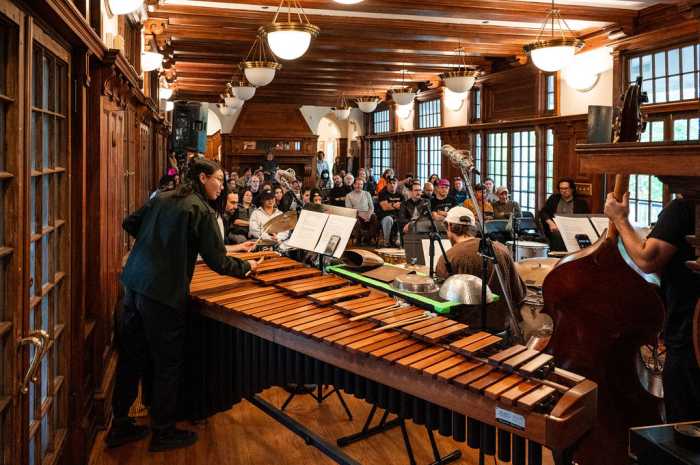When Dr. Louise Pearce, an openly gay pathologist, left New York City for the Congo and helped find a cure for African sleeping sickness in 1918 — saving an estimated 2 million lives — the Spanish flu was already spreading across neighborhoods and tenements back home and would be killing 20,000 New Yorkers at its apex.
It has been said that this deadly flu — which claimed between 50 and 100 million souls worldwide — had dramatically altered global politics, race relations and family structures, while driving innovation in medicine, religion and the arts. It really put humankind’s ingenuity to the test. And, as few women were in STEM careers at the turn of the century, it was Dr. Pearce’s trailblazing spirit that made the male-dominated scientific community take notice.
If you’re intrigued by this compelling historic story, don’t miss “Distemper,” an award-winning short (18 min.) starring Abigail Hawk (“Blue Bloods” on CBS) and Chiké Okonkwo (“Being Mary Jane”). The plot for the TV series pilot-turned-film was created by biologist and writer Max Pitagno and directed by indie TV/film producer Elias Plagianos of Red Hook, Brooklyn. You can catch the screening at the Queens Drive-In, at the Queens Hall of Science, by the Museum of the Moving Image in Astoria, on Friday, April 30, at 7 p.m. This production was filmed on Long Island.
“’Distemper’ could not possibly be more relevant to the health and social crises we are dealing with today! The story tackles all the difficult ethical and moral questions scientists are confronted with when attempting to prevent a pandemic,” Plagianos told QNS.

“In the case of ‘sleeping sickness,’ which was occurring in the Belgian Congo, Louise Pearce was tasked with traveling across the globe to find a cure. Our story finds her at the beginning of that journey: Louise, a lesbian scientist, must convince Noah Jansen, an African living in Belgium, to allow her to help on his crusade to find a cure. On the surface they are two underdogs trying to change the way society treats them, but there are hidden dark agendas also at play, that we hope to explore in a series or perhaps even a feature film version.”
In the film, the audience also learns that Louise’s partner was Sara Josephine Baker, the physician who tracked down Typhoid Mary, the first healthy carrier of typhoid responsible for spreading the disease to numerous people.
“The toxic history of the Belgian Congo, the rubber trade, sleeping sickness, pioneering LGBT female scientists and doctors in 1918. The more I researched, the more interested I became in the project,” Plagianos explained. “When we worked on the shooting script though, I needed a personal connection to make sure the story had a specific point of view. So, Max and I focused on these characters whose voices felt marginalized by industries that did not want to accept them. Characters who were determined to do something extraordinary so their colleagues would take notice.”
Even with a generous grant from the Alfred P. Sloan foundation, it was a real challenge creating a believable world on an independent film budget. Elias spent weeks scouting locations throughout the New York area to attempt to sell New York and the Congo in 1918. It was filmed at Long Island University—C.W. Post in Brookville, Nassau County; The Players Club in Gramercy Park, Manhattan; and at a turn-of-the-century home in Clarkstown, Rockland County. They found a marsh with tall grass along the Hudson River near Piermont, NY, that was used as their Belgian Congo backdrop.
Hawk told QNS that she “dove right into that time period” and discovered how instrumental Dr. Pearce was in finding a cure for trypanosomiasis (African sleeping sickness). “I think at her core she was dedicated to progress, to solving problems, and to treating all human beings as equals. To have made her mark as a pathologist and physician – an award-winning one at that – is truly remarkable,” she said. “The rest, we must fictionalize as authentically as possible, which I believe we achieved in Max and Elias’ pilot presentation script.”
“I lovingly nicknamed her ‘Fierce Pearce,’ and can only imagine what a force of nature she must have been,” Hawk added. “She was, after all, beholden to many of the social constructs of the time, which is what made her request to travel solo across the Atlantic Ocean to the Belgian Congo, such an incredibly bold ask.”
“These women were not ‘out’ in the way our society views sexuality today. Her personal life remains shrouded in mystery, and my research shed quite the dim light on her likely polyamorous relationship with Dr. Baker and writer Ida Wylie,” Hawk continued. “I think people had their suppositions and suspicions, but there really was a lack of gossip about them in general. We know the women lived together; we know they were members of Heterodoxy, a ‘radical feminist’ social group; we know Pearce moved through life in a patriarchal world and, like Dr. Baker, wanted to be respected for her work.
“She probably found a true equal in Dr. Baker and through that relationship, an intellectual outlet and emotional support system lacking in her workplace. I am sure Dr. Baker’s perseverance encouraged Dr. Pearce to follow her heart and her calling. Dr. Pearce’s creativity and ingenuity saved millions of lives.”
The film will be shown at 7 p.m. on Friday, April 30, at the Queens Drive-In, located at 47-01 111 St. in Corona.
Tickets, which cost $20 per car, can be purchased here. New York Hall of Science members receive a free ticket.





































